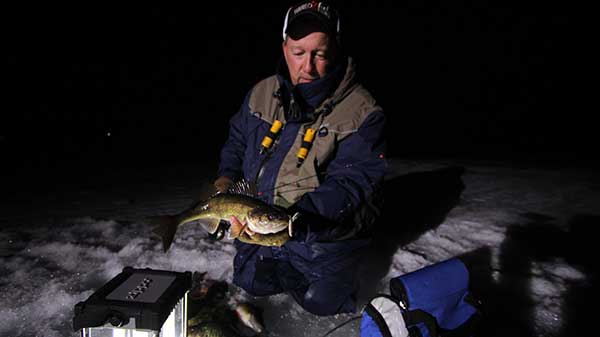(Provided by All Creative Media)
 After-Work Walleyes and Crappies
After-Work Walleyes and Crappies
Long ice fishing trips can be tough to pull off and carving out a full day on the ice can at a challenge for a lot of people.
However, opportunities abound for quick trips offering great fishing shortly after darkness falls.
“My favorites are early evening trips for walleyes or crappies,” says longtime guide, decorated tournament champion and avowed night owl Scott Glorvigen. “With a little planning, it’s easy to get away after work for a couple of hours and enjoy solid action, with a shot at trophy fish.”
Gearing Up: Organization is critical.
“Having everything you need ready and waiting makes it infinitely easier to hit the ice on short notice,” Gorvigen says.
To hasten your departure and boost on-ice efficiency, keep it simple. You don’t have time to move around on the ice like you would during a day-long trip. Night bites are all about hitting high-percentage spots with one or two top techniques.
Glorvigen’s gear includes a small tackle bag stoked with a handful of lures, components and tools; a minnow bucket, two headlamps; an auger; and Lowrance sonar and GPS electronics.
A lantern is also critical equipment.
“I’ve used gas and propane models for years, but last winter I started using Zippo’s battery-powered, LED Rugged Lantern and really like not having to worry about fuel or kicking the light over and burning down the ice shanty,” he says.
Glorvigen houses his gear in a Frabill SideStep flip-over, which sports dual side entries perfect for two-person nighttime expeditions.
When chasing either walleyes or crappies, he packs just four rods. Two are rigged for jigging, and two are set up for bobbering or dead-sticking live bait. “For walleyes, I bring a pair of jigging spoon rods, which allow me to experiment with a few different spoon sizes and colors,” he explains. “Bobber rods are rigged identically. The second merely serves as backup in case the first gets hopelessly tangled or otherwise fouled up.”
Walleye: Jigging rods are strung with 6-pound-test Northland Bionic Braid, with a foot-long, 6- to 8-pound monofilament leader, capped with a round-nosed snap. Bobber rods sport 6-pound mono mainline, a small swivel, and an 18-inch leader of similar material as the jigging setup. A size 4 single hook—either standard bronze or phosphorescent glow—and small split shot pinched six inches above it round out the rig.
“I like braid for spooning, because you get a better hooksets, especially with bigger fish,” he notes. “Mono works great for letting the walleyes run with live bait.”
Glorvigen favors 1/16- to 1/8-ounce Northland Buck-Shot Rattle Spoons, in phosphorescent shades of red and orange. “If it’s glow, it’s a go,” he quips. Spoons are tipped with a minnow head or tail. “Try them both to see what the fish want on a particular night,” he adds.
Crappie: Crappies call for a bit lighter rods and line in the 2- to 4-pound class. Lures lean toward the horizontal orientation, and include favorites like the Northland Bro’s Mud Bug and Gill Getter. “I typically fish glow colors exclusively at night, including phosphorescent blue, red and white,” he says. Spikes and wax worms are top tippings.
Bait presentations: For both species, active jigging attracts attention and triggers its fair share of strikes, while live bait seals the deal with curious ’eyes that look but don’t bite.
Overall, jigging cadences are tailored to the mood of the fish, but Glorvigen generally avoids over-the-top antics that may work in daylight but fizzle after sunset. “Night-bite walleyes are focused on baitfish that are hunkered down for the evening, so they respond better to subtle jig strokes than aggressive lifts and snap-fall sequences,” he explains.
Instead, he relies on a series of twitch-twitch-twitch-pause maneuvers, letting the spoon’s rattles call fish in. “It’s almost like rattling antlers for whitetail deer,” he adds. “Rattle, pause. Rattle, pause. Waiting for a buck to move in.”
When set up over a school of crappies, steady jigging slightly above the fish often tempts hungry slabs to break ranks and rise to the occasion. “Keep jigging and slowly raise the bait,” Glorvigen says. “The higher you get the fish to move up in the water column, the more likely it is to bite.”
To further boost his odds of success, Glorvigen pinpoints potential hotspots by day, and plots their locations for easy return at night.
“Do your homework ahead of time so you’re not hunting for fish after dark,” he says. “For walleyes, look for small shelves and stairsteps along breaklines fish follow from deep water up onto shallow feeding flats. High spots on humps can be good, too.
Crappies typically roam deep basins, but often congregate along some type of structure, such as a steep wall at the edge of a deep hole.
“Any kind of irregular break along that edge, like an inside turn or other collection point, can be particularly productive,” he notes. “Such areas gather and hold schools for longer periods of time, giving you more chances at fish from a stationary position. It’s like setting up in the corner of the corral, instead of along the fence line.”
Walleye action often peaks during the two-hour period surrounding sunset. “With crappies, the bite window is less intense but more spread out, and can continue later into the night,” he adds.





